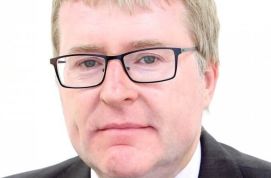Review recommends phased changes to system capital allocation
 The report, Review of the current capital allocation methodology for system envelopes, was written by King’s Fund colleagues chief executive Richard Murray (pictured) and chief analyst Siva Anandaciva. Taking feedback from engagement sessions with, among others, NHS finance directors and the HFMA, and with support from an expert panel, they made nine recommendations.
The report, Review of the current capital allocation methodology for system envelopes, was written by King’s Fund colleagues chief executive Richard Murray (pictured) and chief analyst Siva Anandaciva. Taking feedback from engagement sessions with, among others, NHS finance directors and the HFMA, and with support from an expert panel, they made nine recommendations.
In 2021/22, around £3.9bn was allocated to day-to-day or operational capital. Nationally allocated funds amounting to £1.2bn were made available for strategic projects, such as new hospitals. And the budget for other capital investment was £1.1bn (for programmes such as community diagnostic hubs and mental health dormitory ward replacement).
Of the approximately £3.9bn allocated in operational capital, 56% (£2.2bn) was allocated to cover the full value of trusts’ depreciation. Some 19% (£0.8bn) of the funds related to gross asset values, 9% (£0.4bn) were connected to reported levels of backlog maintenance, and 8% (£0.3bn) is based on the previous six years of reported financial performance. A further 5% (£0.2bn) is allocated to reflect a small number of large nationally approved prior commitments. And 3% (£0.1bn) is allocated to support trusts with issues involving reinforced autoclaved aerated concrete.
The report’s recommendations included retaining the pound-for-pound funding for depreciation, but adjustments due to private finance initiative financing costs should be capped to ensure no trust registers a negative depreciation allocation. Allocations should be based on the latest audited data (2020/21).
With a significant correlation between gross asset values (GAV) and depreciation, the authors recommended reducing and then removing the weighting given to GAV over time. If the weighting is reduced, they called for an increase in the weighting given to backlog maintenance. A cap and collar rule should be adopted to prevent sharp changes, while multi-year allocations would help system planning.
The inclusion in the allocation formula of a weighting for prior-year surpluses offers incentives for financial performance, the report said. And it acknowledged that the weighting is relatively low. However, it also pointed out that some surpluses have been distorted by sustainability and financial recovery funding, as well as Covid funding, over recent years.
It concluded that that ‘distant, historical surpluses’ should not affect current allocations, and recommended a five-year cut-off. It also said the impact of using of prior-year surpluses within the allocation formula was different depending on the size of the overall capital pot in any given year.
Prior-year surpluses might be viewed as acceptable in years when the quantum of capital funding is relatively generous, as essential backlog maintenance and depreciation spending could still be financed. In less generous years, the prior-year surplus adjustment could lead to some ICSs cutting back on essential spending due to their financial performance history.
It is understood that draft capital guidance from NHS England and NHS Improvement adopts many of the recommendations for 2022/23 allocations. These include the increased weighting for backlog maintenance, and reducing the weighting for GAV. Depreciation will be based on the 2020/21 audited accounts. Prior-year surpluses will continue to be part of the formula but with a reduced cut-off point. Primary care business-as-usual capital will also be included in system envelopes in 2022/23.
In their final remarks, Mr Murray and Mr Anandaciva insisted the allocation process cannot sit entirely independently of the overall quantum of available capital funding. And they called for a needs element to be introduced alongside the elements that cover backlog maintenance if sufficient operational capital becomes available. This will be necessary if, over time, budgets for strategic investments that are managed centrally move to ICS control, they added.
Related content
The Institute’s annual costing conference provides the NHS with the latest developments and guidance in NHS costing.
The value masterclass shares examples of organisations and systems that have pursued a value-driven approach and the results they have achieved.